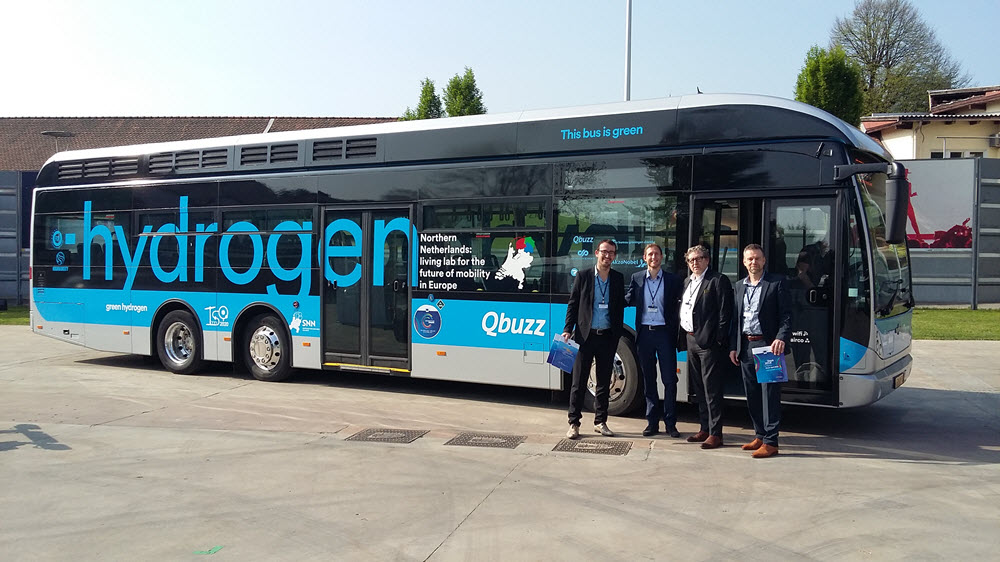European Public Transport: Hydrogen Or Battery Buses? A Realistic Assessment

Table of Contents
Environmental Impact: A Comparative Analysis
The environmental credentials of hydrogen and battery electric buses are central to their appeal. A comprehensive lifecycle assessment is crucial, encompassing production, operation, and end-of-life impacts.
Greenhouse Gas Emissions
- Battery Electric Buses: Emissions are largely determined by the electricity source used for charging. Using renewable energy sources like solar and wind power minimizes the carbon footprint, leading to significantly lower greenhouse gas emissions compared to diesel buses. However, manufacturing batteries requires energy and generates emissions.
- Hydrogen Buses: The emission profile depends heavily on the method of hydrogen production. "Green" hydrogen, produced via electrolysis powered by renewable energy, results in zero tailpipe emissions. However, "grey" hydrogen, derived from natural gas reforming, releases significant amounts of CO2. Transporting and storing hydrogen also consumes energy.
Studies show that battery electric buses powered by renewable energy generally have a lower lifecycle carbon footprint than hydrogen buses using grey hydrogen. However, green hydrogen offers a pathway to zero-emission public transport if renewable energy sources are widely adopted for its production. Data from the European Environment Agency and the International Energy Agency provide further insights into the emissions associated with both technologies.
Air Pollution
Both technologies offer significant improvements in local air quality compared to diesel buses. Battery electric buses produce zero tailpipe emissions, directly reducing particulate matter and NOx pollutants. Hydrogen buses, when using green hydrogen, also offer similar air quality benefits.
However, the production of grey hydrogen can lead to air pollution through the release of NOx and other pollutants. Furthermore, the sourcing and transportation of hydrogen can also introduce indirect air pollution impacts. The immediate air quality improvement offered by battery electric buses is therefore generally considered more substantial.
Infrastructure Requirements and Costs
The establishment of adequate infrastructure is a critical factor in the successful deployment of both hydrogen and battery electric buses. Significant differences exist in terms of the type and scale of infrastructure required, as well as the associated costs.
Hydrogen Infrastructure
Building a hydrogen refueling infrastructure presents substantial challenges. This involves establishing:
- Hydrogen production facilities (electrolysis plants or natural gas reforming plants)
- Hydrogen storage facilities (high-pressure tanks or liquid hydrogen storage)
- A network of hydrogen refueling stations across urban areas
The current lack of widespread hydrogen fueling stations across Europe is a major barrier. The cost of establishing such an infrastructure is also significantly higher compared to that of charging stations for electric buses. Moreover, the environmental impact of different hydrogen production methods needs careful consideration.
Battery Electric Infrastructure
The infrastructure needs for battery electric buses are, comparatively, more mature and readily scalable. This primarily involves:
- Installing sufficient numbers of fast-charging stations at bus depots and strategic locations along routes.
- Upgrading existing electrical grids to handle the increased demand from charging numerous buses.
While grid upgrades can be costly, the cost of establishing a charging infrastructure is generally lower than that of developing a hydrogen refueling network. The scalability of existing electricity grids, especially with smart charging technologies, offers an advantage for battery electric buses.
Operational Considerations
Beyond infrastructure, several operational factors influence the practicality of both bus types.
Range and Refueling/Charging Times
- Battery Electric Buses: Range is currently limited, though constantly improving. Charging times can range from several hours for slow charging to under an hour for fast charging. This might require adjustments to routing and scheduling.
- Hydrogen Buses: Hydrogen buses offer longer ranges compared to current battery electric models. Refueling times are typically faster than charging times for batteries. However, the availability of refueling stations significantly impacts operational flexibility.
Weather conditions can affect both technologies. Cold weather can reduce the range of battery electric buses and impact the efficiency of hydrogen fuel cells.
Maintenance and Operational Costs
Maintenance costs can vary depending on the technology and the age of the vehicles. Fuel costs (electricity vs. hydrogen) also contribute to overall operational expenses. Battery electric buses might have lower maintenance requirements in the long run due to fewer moving parts compared to hydrogen fuel cells. However, battery replacement costs over the vehicle's lifetime should be factored in.
Technological Maturity and Future Prospects
The current state of technology and future advancements influence the long-term viability of both options.
Current State of Technology
Battery electric bus technology is currently more mature and widely deployed across Europe. A range of manufacturers offer commercially viable models. Hydrogen bus technology is still at a relatively early stage of commercial deployment, with fewer manufacturers and limited availability.
Future Developments and Innovation
Significant research and development efforts are underway in both fields. Advancements in battery technology, including increased energy density and faster charging capabilities, are continuously improving the performance of battery electric buses. Similarly, improvements in hydrogen fuel cell efficiency, hydrogen storage, and renewable hydrogen production methods are crucial for increasing the competitiveness of hydrogen buses.
Conclusion
Choosing between hydrogen and battery electric buses for European public transport requires a nuanced approach. Battery electric buses currently offer a more mature and readily deployable solution, benefiting from existing infrastructure and lower upfront costs, particularly if powered by renewable electricity. However, hydrogen buses offer the potential for zero tailpipe emissions using green hydrogen and potentially longer ranges, but this depends heavily on the development of a robust and sustainable hydrogen infrastructure. A balanced strategy, incorporating both technologies where appropriate, alongside continued investment in research and development, will be key to achieving a truly sustainable and efficient future for European public transport. Engage in local discussions to help shape the future of sustainable transportation choices in your community. The continued investigation and innovation in both hydrogen and battery electric bus technologies are crucial for achieving greener cities across Europe.

Featured Posts
-
 Winning Lottery Numbers Wednesday April 16th 2025
May 07, 2025
Winning Lottery Numbers Wednesday April 16th 2025
May 07, 2025 -
 The White Lotus Season 2 Ke Huy Quans Unexpected Voice Appearance
May 07, 2025
The White Lotus Season 2 Ke Huy Quans Unexpected Voice Appearance
May 07, 2025 -
 Anthony Edwards Questions Barack Obamas Legacy
May 07, 2025
Anthony Edwards Questions Barack Obamas Legacy
May 07, 2025 -
 Brwtwkwl Laram Wimbratwr Tezyz Alsyaht Albrazylyt
May 07, 2025
Brwtwkwl Laram Wimbratwr Tezyz Alsyaht Albrazylyt
May 07, 2025 -
 Konklawe Wedlug Ks Sliwinskiego Rola Mediow I Wybor Papieza
May 07, 2025
Konklawe Wedlug Ks Sliwinskiego Rola Mediow I Wybor Papieza
May 07, 2025
